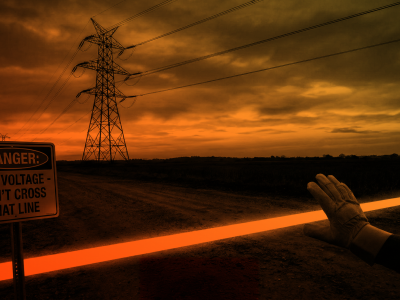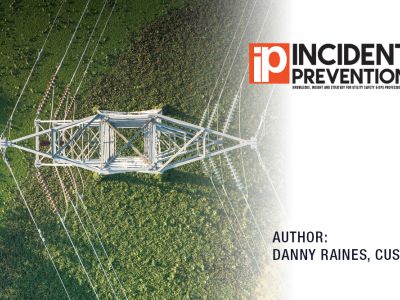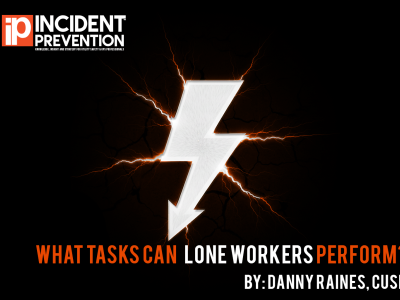
Don’t Cross That Line
In this installment of “Voice of Experience,” I am going to share a safety perspective that struck a real chord with me when someone offered it during a recent meeting. My goal in passing it along during this season of reflection is to prompt readers to contemplate and continue refining their safe work practices. From […]
Accuracy Above All: Authoring Articles for iP Magazine
For over 17 years, I have had the distinct privilege of writing for Incident Prevention magazine. I am genuinely honored that iP continues to publish my articles. My first column was about the four principles of distribution cover-up. At last count, I had written and submitted more than 100 articles over the years. During that […]

Clearing Up Confusion About Host-Contractor Relationships
In my consulting work, I’ve found there is some industry confusion regarding the relationship between a host utility and an independent contractor company. To help provide clarity, I’m going to kick off this installment of “Voice of Experience” with an overview of each party’s obligations from an OSHA perspective. A contract employee performs work covered […]
Bucket Truck Safety: OSHA Standards and Other Considerations
I receive numerous and varied questions about the safe use of bucket trucks in electric utility operations, so in this installment of “Voice of Experience,” I am going to share with you the OSHA standards you need to know as well as some things I have discovered during observations and audits of field crews. First, […]
A Checkup from the Neck Up
The pastor of the church I attend recently delivered a sermon that deeply resonated with me and inspired the title of this article. Around that time, I’d been ruminating on some incidents I was investigating as part of my consulting work. I’d read the accident reports and conducted employee interviews, all the while wondering why […]
To Improve On-the-Job Safety, Consistency and Continuing Education are Key
It’s a little late to say Happy New Year, but I still want to wish all of you a fantastic and safe 2025. One of my hopes for this year is that I won’t be asked to investigate another incident or fatality – because we’ll all work together to ensure they never occur. We’ve had […]
Don’t Do This: Lessons Learned in the Field
I was so excited when I became a journeyman lineman in the early 1970s. In those days, there was no such thing as a journeyman ticket – a union member or business agent would let you know that you had arrived. Seniority alone was the driver. I was a union lineman in IBEW 84/896 located […]
The Meter Base Checkout Procedure
To emphasize the critical importance of the meter base checkout procedure, this installment of “Voice of Experience” will cover the proper procedures for (1) checking out a meter base before setting a self-contained meter on new services and (2) resetting a meter after it has been removed and the base has not been in use. […]

What Tasks Can Lone Workers Perform?
Over the course of my career in the utility industry, I’ve often been asked what tasks lone workers are allowed to perform on their own. It’s sometimes a hotly debated topic – both legally and ethically – and the answer is very much based on the employer. Each employer determines which tasks are allowed to […]
Apprentice Development Programs: What Should be Included?
Over the years, I have received many questions asking what it takes to become a journeyman lineworker after being hired as an apprentice. In response, I have prepared the following overview of the skills training I believe needs to be covered. Please note that this is only an overview; some companies will need to deliver […]

Ruling Spans and Proper Conductor Sag
The cold winter weather of recent months has prompted many conversations about proper sagging and tension on transmission and distribution conductors. Improper sagging and excessively high tension on conductors – past their rated breaking strength – have caused unscheduled system outages, but such outages can be avoided by using the correct loading factors. The system […]
Determining Reasonable Energy Estimates
During a recent audit at a utility, it was discovered that the method used to determine incident heat energy was not appropriate for the utility’s application. Discussions with other utilities and subject matter experts indicate that the methods to determine the amount of exposure are challenging. It is unknown whether these are localized findings or […]
Understanding and Preventing Ferroresonance
Ferroresonance is a term and condition not often heard about in electric utility work. Nonetheless, it’s important to know about ferroresonance because it is an immensely hazardous condition that can result in arc flash injuries and damaged equipment. The Electrical Engineering Portal offers this scientific definition of the word at https://electrical-engineering-portal.com/download-center/books-and-guides/schneider-electric/ferroresonance: “Ferroresonance is a non-linear […]
Understanding Task-Specific Training
If an employer must defend their company in the event of an incident or accident, training records are a critical tool. There is nothing better to present during an OSHA investigation or a civil tort liability case than documented training records and annual reviews of the proficiency demonstrations that are required by the OSHA standard. […]
Equipotential or Total Isolation?
System grounding is one of the topics that people ask me about most, which is great because I have always found temporary system grounding for employee protection to be a fascinating subject. I performed bracket grounding all throughout my years spent working on line crews in the 1970s and ’80s. I was taught that it […]
Lineworkers and Rubber Sleeves
I am often asked about the benefits of wearing rubber sleeves. Personally, I never had to wear them as an apprentice or a lineman because of my former employer’s belief that an insulate-and-isolate program was the best way to go. Even today, the company that employed me for over 40 years does not require lineworkers […]
Planning for Storm Work
The strength and magnitude of a storm should determine our methods to address it. But long before a significant event occurs, a plan to restore power safely should be made by the host company. I learned during my early days as a supervisor that a storm evaluation and restoration plan is of great value to […]
Arc Flash Precautions: A Review
David McPeak hosts the Incident Prevention Institute Forum (https://ip-institute.com/ipi-forum/) once a month. I often take part as a panelist, helping to answer questions posed by forum attendees. During a recent forum, topics ranged from fleet mechanics to arc flash exposures and required personal protective equipment. I decided I’d dedicate this installment of “Voice of Experience” […]
Ground Gradient Step Potential and PPE
For various reasons, ground gradient step potential hazards are not always considered or thought to be important. I recently received a call from a large investor-owned utility whose employees had differing opinions about using super dielectric overshoes or work boots when setting a pole in an energized line. Some people are of the opinion that […]
The Importance of Proper Coverup: Two Real-Life Tales
Very early on in my career as a lineman, I was involved in two events that taught me some important lessons about proper coverup and how critical it is to worker safety. Both events occurred between 1972 and 1973. I was working on a big line crew, and while there were different crew foremen, there […]

